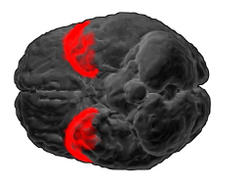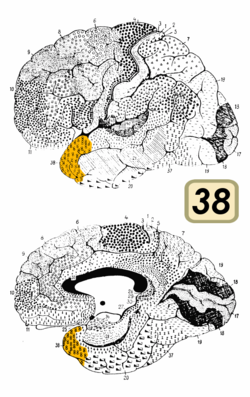Brodmann area 38
| Brodmann area 38 | |
|---|---|
 | |
 | |
| Details | |
| Identifiers | |
| Latin | area temporopolaris |
| NeuroLex ID | birnlex_1771 |
| FMA | 68635 |
| Anatomical terms of neuroanatomy | |
Brodmann area 38, also BA38 or temporopolar area 38 (H), is part of the temporal cortex in the human brain. BA 38 is at the anterior end of the temporal lobe, known as the temporal pole.
BA38 is a subdivision of the
ectorhinal area 36
(Brodmann-1909).
The temporal pole is a
semantic memories) that are stored in the ventral anterior temporal lobe are imbued with emotional significance and personal meaning.[1] In addition, concepts of individual people, abstracted away from the perceptual representations, are stored in a “face patch” in the temporal pole. This face patch is found in both non-human primates and humans.[2] This relates to early work showing that damage to the temporal pole can cause an amnestic prosopagnosia in which knowledge of familiar people is lost.[2]
Bilateral damage to the temporal poles, though rare, can cause dramatic changes in personality.
Kluver-Bucy syndrome involves damage to the greater temporal pole as well as the amygdala. In this disorder, people and animals demonstrate fearlessness, hypersexuality, and hyperorality[1]
This area is among the earliest affected by Alzheimer's disease, frontotemporal dementia, frontotemporal lobar degeneration, and is commonly involved at the start of temporal lobe seizures.[3]
Cytoarchitectonic and chemoarchitectonic studies find that it contains at least seven subareas, one of which, "TG", is unique to humans.[3]
See also
References
External links
Wikimedia Commons has media related to Brodmann area 38.
